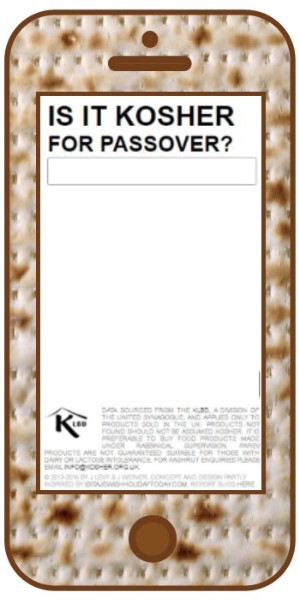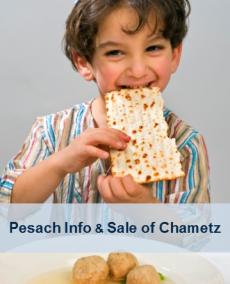Step 1 – Don’t Panic!
Pesach is not as difficult or as expensive as you think. It doesn’t have to be a “spring clean” and you don’t need to scrub the paintwork, wash the curtains, or empty the airing cupboard. One only has to search and clean for chametz in places where there is a reasonable likelihood that cake or biscuits (for example) may have been left. (Admittedly if you have young children, this includes almost everywhere below three-foot-six). It does usually exclude high shelves and cupboards, the garden shed and underneath the keys of your keyboard (unless you eat your supper at the computer!)
Step 2 – House Cleaning
This can be fun! Get the older children to join in. Start on the outside. (ie bedrooms, playrooms), and work inwards (towards the kitchen) creating “chametz-free zones” as you go. Remember to check behind bedside tables (if you’ve brought tea to bed!) and the children’s toy box and coat pockets.
Step 3 – The Pesach Order
If you find Pesach terribly expensive, shop around to get the best deals!
Step 4 – The Pesach Teach-In
Many shuls and adult education programmes arrange a Pesach “teach-in” or demonstration Seder. This will give you some idea of what the frantic activity is all for, and will also provide an opportunity to get any practical queries answered.
Step 5 – Selling the Chametz
This is most, most important, - it is also very simple and does not cost anything. The Torah not only forbids us from eating chametz on Pesach, we are also instructed not to own any (see Exodus 12,19 &13,7).
We all have stacks of chametz food (cereals, baking powder, powdered soups, etc, all of which contain wheat (flour or yeast) and crates of beer or whiskey (which are distilled from grain). Ideally one would finish it all off before Pesach, but should this prove impossible another alternative is to relinquish ownership by locking it all away and selling it to a non-Jew. Though the non-Jew usually sells it back after Pesach this is an entirely valid legal sale both in Jewish and English law. It is preferable to go into shul during the week prior to Pesach to sign your name on the rabbi’s contract, but if this is difficult it can be done online here or by downloading and posting the form here.
Step 6 – Koshering “keilim” (utensils)
The laws of koshering are complex. In a word …don’t! Is it really worth all the time and effort? In this day and age it is so much easier to buy a cheap set of glasses or cutlery or buy disposables which would be quite sufficient for the week of Pesach.
Some communities offer a local service whereby a small number of utensils that have been used during the year may be kashered for Pesach.
Step 7 – Kitchen Cleaning
Here again, let’s take the easiest way. Seal off and sell as many cupboards as possible and those cupboards needed for Pesach clean thoroughly and cover the shelves with paper.
Step 8 – The Cooker and Fridge
Cover all surfaces with plastic or other suitable material which won’t tear. A stainless steel sink can be thoroughly cleaned and kashered by pouring on boiling water direct from the kettle. Other sinks should be covered with foil or adhesive Fablon.
The fridge is easy, merely requiring a thorough clean out. The cooker, and in particular the oven, is the hardest and most important job of all (there is no point in baking with potato flour in a chametz oven), so leave yourself plenty of time. But briefly, it is sensible (and easiest) to get new pan supports and oven shelves from the manufacturers. Failing this, such parts should be thoroughly cleaned and, on gas cookers, covered with a metal grid or a double layer of silver foil. The oven must be scrupulously cleaned so that no trace of chametz remains and then heated on the highest heat setting for an hour and a half. It is recommended that the oven ceiling be covered with silver foil, or at least the top shelf so covered and not used. Take care not to cover the apertures.
Step 9 – The Chametz Corner
A few days before Pesach, it is time to “go Pesachdik” and start the cooking and baking (unless you are lucky enough to have a separate Pesach kitchen in which case you are probably already half way!). If at all possible, set up a little “Chametz corner” with an electric ring in the morning room or laundry room – or even the hall – so that the kitchen can be completely Pesachdik.
Step 10 – Cooking and Baking
There are many delicious recipes for Pesach, so choose a good Pesach cook book from the wide range available.
Step 11 – “Bedikat Chametz”
On the night before Pesach, as soon as possible after nightfall, begin the “official” search for Chametz. This is not a mere ritual but should be a proper and thorough search. It is said that the reason behind the custom of putting out ten small pieces of bread beforehand is to stimulate everyone to search properly. (Make sure that someone knows where the pieces are and that crumbs are not scattered around in the process). Gather the children, a candle, a feather and a piece of wood or bag (the original dustpan and brush), make the bracha (….al Biyur Chametz) usually found at the beginning of the Hagadah and proceed through the entire house searching all corners and crevices.
It is permissible – even possibly preferable – to use an electric torch, which is easier, safer and more effective, but it is nice to begin with a candle in the centuries-old tradition.
Step 12 – “Biyur Chametz”
On Erev Pesach men should go to shul for the fast of the First Born Siyum. Final breakfast and elevenses must be over by the “fourth hour of the day”. Any remaining chametz (which is not being sold) must be taken outside and destroyed by the “fifth hour”. For exact timings this year, click here. There is also a custom to burn last year’s dried up lulav and Hoshanat together with the chametz and this certainly makes a good blaze. (Those who genuinely find it difficult to burn the chametz may destroy it in some other way, (eg flushing it down the toilet). After destroying the chametz it is very important to say the Kol Chamirah declaration in a language which one understands:” All manner of leaven which is in my possession, whether I have seen it or not, whether I have removed it or not, should be annulled and ownerless like the dust of the earth”.
Step 13
Everyone has their own peculiar Pesach problem, be it the goldfish, the rabbit, the au-pair, or the caravan. Whatever it is, don’t forget to sort it out!
Step 14 – Preparations for the Seder
As well as not eating bread on erev Pesach, matza is also strictly off limits until the Seder (so remember to prepare something for lunch, particularly as you can’t grab a snack of crackers or Ryvita!)
Make sure the kids get some rest so they are awake and alert at the Seder. Here is a brief checklist of Seder items:
Matza All matza used for the mitzva on Seder night should be Shemura, which is baked specifically for the purpose of the mitzva – often, though not necessarily, by hand – from grain which, from the moment it was cut, was guarded against any dampness which could cause it to become chametz.
On each of the three occasions that matza is eaten during the Seder ceremony, one must eat a kazayit which is a piece four inches by seven (10 x 18cm).
Wine Everyone needs a wine glass for the four cups, which should be large enough to contain at least 3.3fl oz (86cc).
Maror Many people use raw horseradish for maror which is certainly rather bitter. However, lettuce and chicory (endives) are also acceptable and are a lot more palatable. This is worth bearing this in mind since one is supposed to eat a kazayit of maror too! Lettuce in particular should be thoroughly washed to be sure all insects are removed.
Karpas Any vegetable may be used for karpas, but many have the custom to use potato or parsley.
There are four other special items needed for the Seder: the charoset, the salt water, the roasted bone and the roasted egg.
Step 15 – The Seder
Everyone is finally gathered around the beautiful festive table. Make sure there is a modern, intelligible and lively Hagadah for each person as the Hagadah should be understood by all. In what is probably the only reference to English in early halachic sources, the Shulchan Aruch says, “So did Rabbenu Yitzhack of London (13th century). He translated the Hagadah into the vernacular so that the women and children should understand it”.
Long before audio-visual educational aids were ever thought of, our sages ingeniously designed the Seder as a dramatic and experimental reliving of the event.
We all experience the bitterness of that slavery (Maror), the salty tears (Karpas) the punishing power of the Ten Plagues (spilling the wine), the bread of affliction (Matza), the joy and exhilaration of salvation (Four cups and Hallel) and we finish off with the dry taste of the Matza (Afikomen) as we look to the future and sing ‘Leshana haba'ah b’Yerushalayim – next year in Jerusalem’. Spare a thought too for our brethren unable to celebrate Pesach as we do in freedom. Make sure everyone, young and old, joins in, for only with tasting comes understanding.
And as the Seder draws to a close, don’t forget to add a silent prayer that G-d should grant you the strength to do it all again next year.
15 Steps to Freedom
Date Uploaded:
Wednesday 1st April 2020




